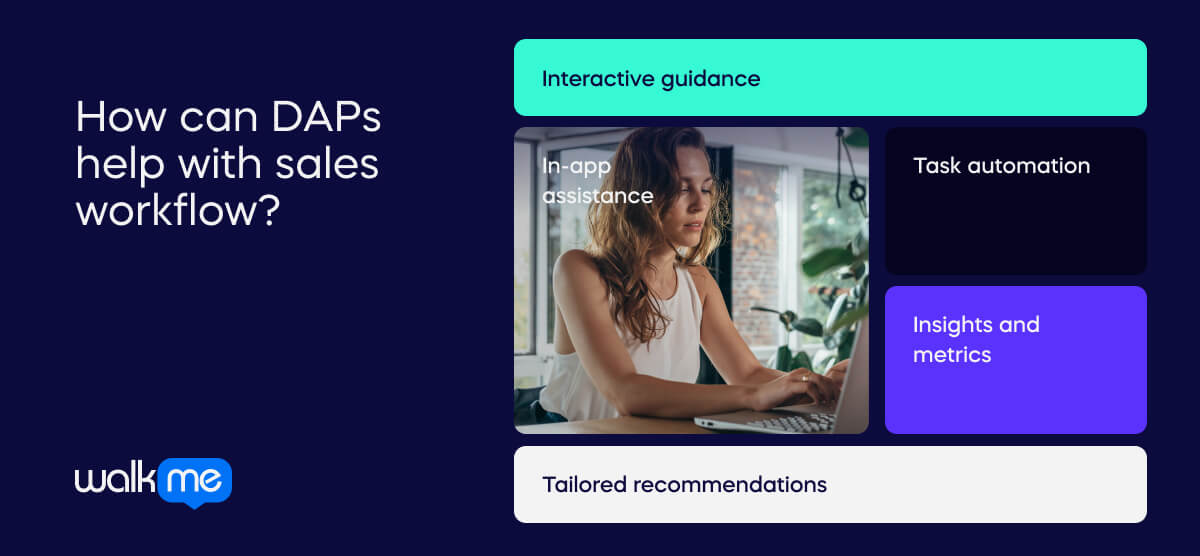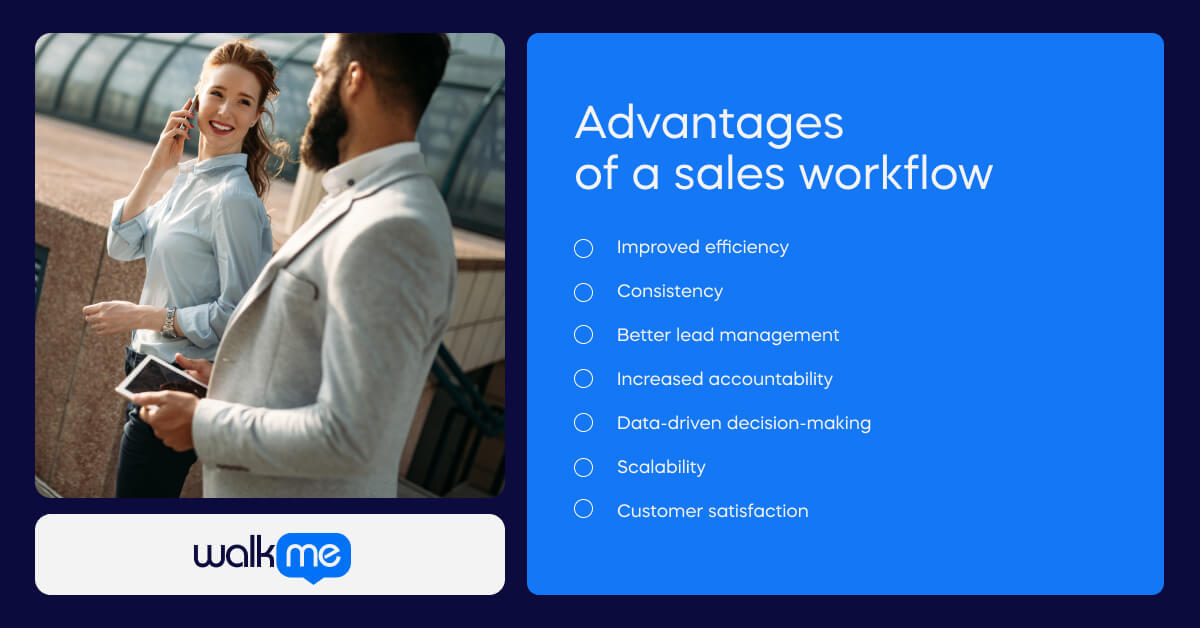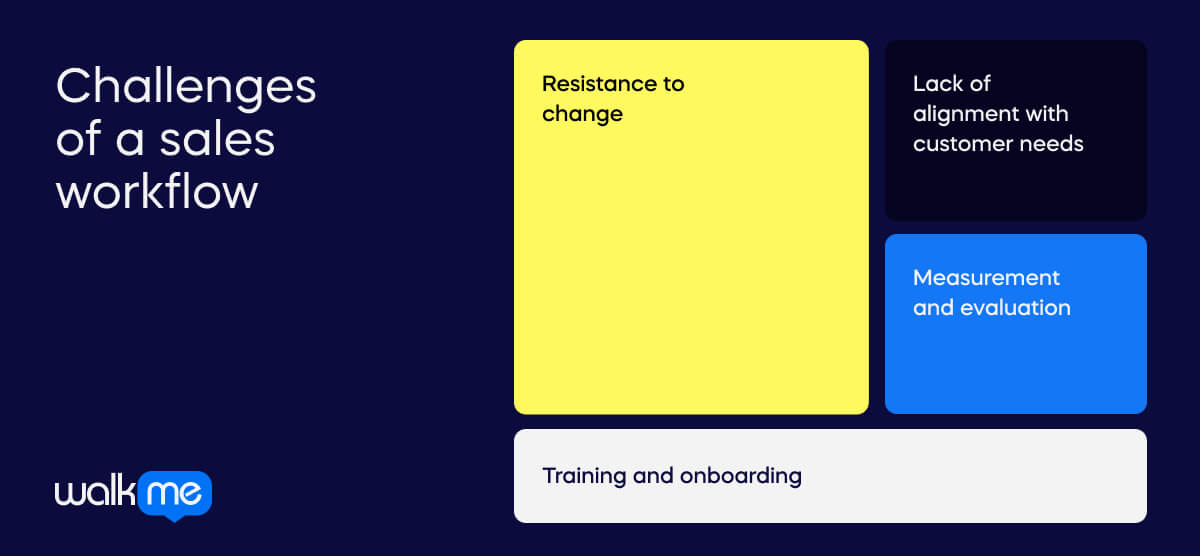A sales workflow is a structured series of steps or processes. Sales professionals follow it. They do so to move a potential customer through the sales cycle. This cycle begins at the stage of initial contact and moves through to closing the deal.
The workflow outlines the steps that sales representatives need to take. They will know what actions, tasks, and interactions are required. The goal is to quickly and effectively turn leads into customers.
The specific steps and stages of a sales workflow can vary. It depends on the industry, company, and product or service being sold.
However, typical stages might include:
- prospecting
- lead qualification
- needs analysis
- solution presentation
- negotiation
- closing
There may also be post-sale steps. These can include follow-up, customer support, and account management.
Sales workflows can be manual, automated, or a combination of both. Tools such as customer relationship management (CRM) software can be used. A CRM works to track leads, manage contacts, and streamline communication.
Following a defined workflow is beneficial for sales teams. They can improve their productivity and consistency and, ultimately, their success in generating revenue.
How can DAPs help with sales workflow?

It’s safe to say that sales reps are struggling with their workflows. For example, Salesforce reveals that reps spend just 28% of their week selling. This is down from 34% in 2018.
Furthermore, LinkedIn highlights how ‘dirty data’ is causing problems. 45% of sellers surveyed reported that their biggest data challenge was incomplete data.
DAPs like WalkMe can help sales representatives with their workflows. Here is how several of WalkMe’s features can assist:
Interactive guidance: WalkMe can provide step-by-step walkthroughs for new sales representatives during onboarding. These can help new hires to understand CRM systems, sales tools, or processes. Employees can understand the essentials and quickly begin contributing to the team.
In-app assistance: The platform offers real-time guidance. It can be provided within CRM systems and other sales tools. Sales reps receive contextual prompts. These help employees to:
- navigate complex processes
- learn to input data accurately
- adhere to best practices in the workflow
Task automation: Businesses can automate repetitive tasks with a DAP like WalkMe. These could be appointment scheduling, data entry, or follow-up emails. As a result, sales reps have their time freed up.
Insights and metrics: WalkMe provides performance analytics for the sales workflow. Metrics like conversion rates, sales cycle length, and pipeline velocity are tracked. Sales managers can identify bottlenecks and optimize processes. They can coach reps based on data-driven insights.
Tailored recommendations: The software delivers personalized coaching to individual sales reps. This could be improvement suggestions, upselling opportunities, or recognition. The team will be motivated and empowered by such targeted feedback.
Use cases for a sales workflow
Sales workflows in business
Here are three examples of how sales workflows appear in different business scenarios.
E-commerce sales workflow
Prospecting: Identifying potential customers through website visitors, social media interactions, or previous customers.
Lead qualification: Working out which customers could be leads. This is decided using browsing behavior, demographics, and purchase intent.
Solution presentation: Showcasing products or services. These are presented on product pages. The site will also provide personalized recommendations and targeted promotions.
Checkout process: Guiding customers through the checkout process. This includes entering shipping and payment information and offering upsell or cross-sell options.
Post-sale follow-up: Sending order confirmations and shipping notifications. The site may request feedback to encourage repeat purchases.
B2B sales workflow
Prospecting: Identifying potential clients through networking events, industry conferences, or referrals.
Needs analysis: Understanding the specific challenges and requirements of potential clients. This information is gathered through meetings, consultations, and assessments.
Proposal submission: Developing and presenting tailored proposals or quotes. These are designed to address the client’s needs and objectives.
Negotiation and contracting: Negotiating terms, pricing, and contract details. The aim is to reach a mutually beneficial agreement.
Implementation and onboarding: Assisting clients with implementing the purchased solution, providing training, and ensuring a smooth transition.
Account management: Providing ongoing support, addressing concerns, and nurturing the client relationship. The goal is to encourage long-term satisfaction and loyalty.
SaaS sales workflow
Lead generation: Generating leads through inbound marketing strategies. These could include content marketing, SEO, and paid advertising.
Trial sign-up: Encouraging prospects to sign up for a free trial or demo of the software. They can experience its features and benefits firsthand.
User onboarding: Guiding trial users through the onboarding process. This includes setting up their account, configuring settings, and completing initial tasks.
Usage analysis: Monitoring trial user activity and engagement within the software. The aim is to identify areas of interest and potential roadblocks.
Conversion and upselling: Converting trial users into paying customers. This is done by demonstrating the value of the software. The company may also offer tailored pricing plans or additional features.
Customer success: Providing ongoing support, training, and resources. This helps customers maximize the value they receive from the software. It also reduces churn.
Success stories with sales workflow
WalkMe has helped many companies to improve their sales workflows. Here’s an example:
W.L.Gore
Challenge:
Gore recognized that their sales processes were not unified. This was causing inefficiencies for the organization.
They shifted sales reps to Salesforce, which helped them have a common approach. However, they were struggling with user adoption.
Gore needed a way to increase engagement with Salesforce. They also wanted to communicate updates on time.
Solution:
WalkMe delivered just-in-time training for sales reps. Walk-Thrus, SmartTips, and Launchers were used to train them.
Using behavior-based segmentation, the software ensured all associates completed the required training.
Sales reps at Gore have adopted – and now prefer – an all-digital training approach.
Results:
- Reduced sales rep enablement time by 75%
- Removed over 400 meeting hours for the sales teams
- Reduced training time by over 83%
- Experienced a 154% YoY boost in Salesforce user sessions
Sales workflow vs sales methodology
Sales workflow and sales methodology are related concepts. However, they serve different purposes within the sales process.
- A sales workflow defines the specific steps and processes within the sales cycle
- A sales methodology provides the overarching framework for engaging with customers
Both are important components of a successful sales strategy. The sales methodology guides the approach and workflow, outlining the execution.
Let’s look at how the two terms differ:
Sales workflow
Definition: A series of steps that sales professionals follow. They want to move a potential customer through the sales cycle. The first step is initial contact, and the last is closing the deal.
Focus: The operational and procedural aspects of selling. It outlines specific actions, tasks, and interactions. Sales representatives need to follow these at each stage of the sales process.
Examples:
- Prospecting
- Lead qualification
- Needs analysis
- Solution presentation
- Negotiation
- Closing
- Post-sale follow-up
Implementation: Sales workflows can be manual, automated, or a combination. They use tools such as CRM software. The goal is to track leads, manage contacts, and streamline communication.
Sales methodology
Definition: An overarching approach or framework. It tells sales professionals how to engage with prospects and customers. The guidance is given for the entire sales process.
Focus: The strategic and tactical aspects of selling. It provides principles, techniques, and best practices. These are applied to building relationships, addressing customer needs, and closing deals.
Examples:
- Consultative selling
- Solution selling
- Challenger selling
- SPIN selling
- Inbound selling
Implementation: Sales methodologies are an overarching framework. They inform how sales teams should approach selling. This includes how to:
- conduct discovery meetings
- handle objections
- present solutions
- negotiate terms.
Advantages of a sales workflow

Implementing a sales workflow offers several advantages for businesses and sales teams:
Improved efficiency: A well-defined sales workflow streamlines the sales process. It reduces the time and effort required to move leads through the pipeline. Standardizing procedures and automating repetitive tasks helps sales representatives. They can focus more on high-value activities. These include building relationships with prospects and closing deals.
Consistency: A sales workflow ensures that all sales representatives follow a standardized approach. This applies to selling promoting consistency in messaging, actions, and customer interactions. This consistency enhances the customer experience. It also helps build trust and credibility with prospects. This leads to higher conversion rates and customer satisfaction.
Better lead management: A clear sales workflow is important for sales teams. They can effectively manage leads throughout the sales cycle. For example, they can categorize leads based on their stage in the pipeline and prioritize follow-up activities. This allows sales representatives to focus their efforts on the most promising opportunities. As a result, they increase their chances of success.
Increased accountability: A sales workflow establishes clear expectations for sales representatives. It outlines the specific tasks they need to achieve at each stage of the sales process. This clarity improves accountability within the sales team. Sales managers can track progress, identify bottlenecks, and provide targeted coaching.
Data-driven decision-making: Implementing a sales workflow supported by CRM software or other analytics tools is helpful. Businesses can collect valuable data on sales performance and customer interactions. This data enables sales managers to:
- identify trends
- measure the effectiveness of different sales strategies
- make data-driven decisions
This optimizes the sales process and drives better results.
Scalability: A scalable sales workflow allows businesses to handle growing sales volumes. They are also able to expand into new markets more effectively. By documenting and refining sales processes, businesses can:
- onboard new sales representatives more efficiently
- ensure continuity during periods of growth
- adapt their approach to meet evolving market conditions
Customer satisfaction: A well-executed sales workflow focuses on understanding and addressing customer needs. It is relevant throughout the buying journey. By delivering a consistent and personalized experience, businesses can:
- enhance customer satisfaction
- foster long-term relationships
- encourage repeat business and referrals
Challenges of a sales workflow

Implementing a sales workflow has many advantages. But it also has its own challenges. Some common challenges of a sales workflow include:
Resistance to change: Introducing a new sales workflow may not go down well with some employees. They may be accustomed to existing processes. They could also be skeptical about the benefits of change. Overcoming this resistance requires effective communication, training, and leadership buy-in. The goal is to ensure widespread adoption and acceptance.
Lack of alignment with customer needs: It is important for sales workflows not to be too internally focused. If they fail to align with customer needs, this can lead to missed opportunities and decreased effectiveness. It’s essential to incorporate customer feedback and insights. This ensures the design of the sales workflow delivers value and resonates.
Measurement and evaluation: Having clear metrics and performance indicators in place is vital. Otherwise, it is difficult to measure the effectiveness of a sales workflow. It can also be tricky to identify areas for improvement.
Sales teams should track KPIs such as:
- conversion rates
- sales cycle length
- customer satisfaction
This can only be properly done with the right tools and analytics capabilities.
Training and onboarding: Implementing a new sales workflow requires thorough training and onboarding for sales representatives. They must understand the processes, tools, and expectations. Inadequate training or lack of ongoing support can lead to confusion, mistakes, and suboptimal performance. This undermines the success of the sales workflow.
The future of sales workflows
As we look to the future, the evolution of sales workflows is likely to be heavily influenced by the continued development of DAPs.
These platforms are expected to become more sophisticated. They will likely use AI and machine learning to provide more nuanced and adaptive support.
This will enable sales teams to focus on what they do best—selling. Meanwhile, the DAPs will handle the complexities of guiding and tracking the sales process.
The future of sales workflows promises a more streamlined, intelligent, and responsive system. DAPs will play a crucial role in enhancing the sales process.
This will not only improve sales teams’ performance but also lead to a better customer buying experience. Ultimately, it will contribute to the long-term success of businesses.